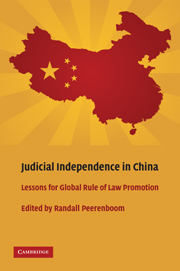Book contents
- Frontmatter
- Contents
- Contributors
- 1 Introduction
- 2 Halfway Home and a Long Way to Go
- 3 A New Approach for Promoting Judicial Independence
- 4 The Party and the Courts
- 5 Judicial Independence in China
- 6 A New Analytic Framework for Understanding and Promoting Judicial Independence in China
- 7 Judicial Independence and the Company Law in the Shanghai Courts
- 8 Local Courts in Western China
- 9 The Judiciary Pushes Back
- 10 Corruption in China's Courts
- 11 A Survey of Commercial Litigation in Shanghai Courts
- 12 Judicial Independence in Authoritarian Regimes
- 13 Judicial Independence in East Asia
- Index
13 - Judicial Independence in East Asia
Lessons for China
Published online by Cambridge University Press: 05 June 2012
- Frontmatter
- Contents
- Contributors
- 1 Introduction
- 2 Halfway Home and a Long Way to Go
- 3 A New Approach for Promoting Judicial Independence
- 4 The Party and the Courts
- 5 Judicial Independence in China
- 6 A New Analytic Framework for Understanding and Promoting Judicial Independence in China
- 7 Judicial Independence and the Company Law in the Shanghai Courts
- 8 Local Courts in Western China
- 9 The Judiciary Pushes Back
- 10 Corruption in China's Courts
- 11 A Survey of Commercial Litigation in Shanghai Courts
- 12 Judicial Independence in Authoritarian Regimes
- 13 Judicial Independence in East Asia
- Index
Summary
Like many countries around the world, China is increasingly interested in promoting the rule of law and judicial independence. A competent and professional judiciary is a central component of the “socialist rule of law,” and China has made significant investments in institutional quality. Scholars disagree, however, about the efficacy of these reforms to date. Just as we have few appropriate points of comparison for assessing China, China has few points of reference for designing reforms.
This chapter explores the experience of China's East Asian neighbors with regard to judicial independence, with an eye toward drawing lessons for China's own reforms. Japan, South Korea, and Taiwan collectively provide a useful vantage point to examine developments in China because their rapid growth from the 1950s through the 1990s represents the greatest sustained example of rapid growth in world history. The only comparable period of growth is that of contemporary China, now nearing the end of its third decade. The East Asian cases are also relevant to China because the countries in the region share certain cultural traditions, and because many of them developed their judicial systems during periods of authoritarian governance. Finally, the East Asian cases, like contemporary China, seem to challenge the conventional wisdom that a powerful legal system is necessary for sustained economic development. My argument is that these cases provide nuanced lessons for the Chinese case about the definition of and conditions for judicial independence.
- Type
- Chapter
- Information
- Judicial Independence in ChinaLessons for Global Rule of Law Promotion, pp. 247 - 259Publisher: Cambridge University PressPrint publication year: 2009
- 11
- Cited by

